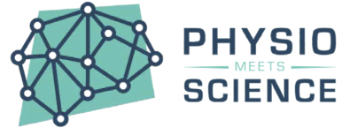
Sehnenpathologie: Behandle den Donut, nicht das Loch!
Häufige Mythen bei einer Tendinopathie…
Viele Therapeuten sind der Überzeugung, dass man die Struktur der Sehne verbessern müsse und könne, um eine Schmerzreduktion zu erreichen.
Gleichzeitig haben viele Patienten bedenken, eine „vorgeschädigte“ Sehne zu belasten. Sie fürchten eine Ruptur der Sehne und sehen kein wirkliches Potenzial, sich durch Belastungsprogramm zu verbessern, was die Adhärenz für übungsbasierte Therapieprogramm gefährden kann.
Deshalb ist es wichtig, Folgendes zu wissen…
Die momentane Evidenz spricht gegen die Möglichkeit, die Pathologie bei einer degenerativen Tendinopathie zu verändern. Um Schmerz und Funktion zu verbessern, ist dies allerdings auch nicht nötig1,4,5,6.
Und noch wichtiger…


Sehnen mit einer Tendinopathie haben zwar mehr pathologische Anteile (rot, re. Abbildung) als eine normale Sehne (li.)…sich nicht überraschend ;-).
ABER …Pathologische Sehnen sind dicker. Die Querschnittsfläche der „guten Sehnenstruktur“ („aligned fibrillar structure“, in blau/grün) ist in pathologischen Achilles- und Patellarsehen
signifikant ERHÖHT (Tabelle nächste Slide). PATHOLOGISCHE SEHNEN HABEN ALSO MEHR „GUTE STRUKTUR“ ALS GESUNDE SEHNEN1,2. Progressive Sehnenbelastungen haben das Potenzial, diese gesunden Strukturen weiter zu verbessern. Und diese gute Struktur sorgt auch für einen Schutz vor Rupturen7.
| Achillessehne (gesund, n=36) | Achillessehne (patholog., n=30) | Patellarsehne (gesund, n=20) | Patellarsehne (patholog., n=30) | |
| AP-Durchmesser (mm) | 6,5 +/-0,5 | 8,4 +/- 1,5** | 6,0 +/- 0,6 | 7,8 +/- 2,6** |
| Querschnitt – gute Struktur (mm2) | 80,8 +/-15,4 | 94,8 +/- 26,5** | 125,9 +/- 11,7 | 139,9 +/- 23,1** |
| Querschnitt – pathologische Struktur (mm2 ) | 1,4 +/-1,4 | 4,7 +/- 8,3** | 4,5 +/-3,4 | 17,1 +/- 22,3 |
Deshalb….
„BEHANDLE BEI TENDINOPATHIEN DIE GESUNDE STRUKTUR (DEN DONUT), NICHT DIE PATHOLOGIE (DAS LOCH). ES IST GENUG DAVON DA!“
Und bedenke….
…“die Anpassung in einem Gewebe ist nur einen Teil der Anpassung eins Individuums.3
“Treat the person and the donut, not the hole”!
Literaturangaben
- Docking, S., Rosengarten, S., Daffy, J., & Cook, J. (2014). Treat the donut, not the hole: The pathological Achilles and patellar tendon has sufficient amounts normal tendon structure. Journal of Science and Medicine in Sport, 18, e2.
- Docking, S. I., & Cook, J. (2016). Pathological tendons maintain sufficient aligned fibrillar structure on ultrasound tissue characterization (UTC). Scandinavian journal of medicine & science in sports, 26(6), 675-683.
- Docking, S. I., & Cook, J. (2019). How do tendons adapt? Going beyond tissue responses to understand positive adaptation and pathology development: A narrative review. Journal of musculoskeletal & neuronal interactions, 19(3), 300.
- Rio, E., & Docking, S. I. (2018). Adaptation of the pathological tendon: you cannot trade in for a new one, but perhaps you don’t need to?.
- Cook, J. L., Rio, E., Purdam, C. R., & Docking, S. I. (2016). Revisiting the continuum model of tendon pathology: what is its merit in clinical practice and research?. British journal of sports medicine, 50(19), 1187-1191.
- Cook, J. L., & Docking, S. I. (2015). “Rehabilitation will increase the ‘capacity’of your… insert musculoskeletal tissue here….” Defining ‘tissue capacity’: a core concept for clinicians.
- Cook, J. L. (2018). Ten treatments to avoid in patients with lower limb tendon pain.
